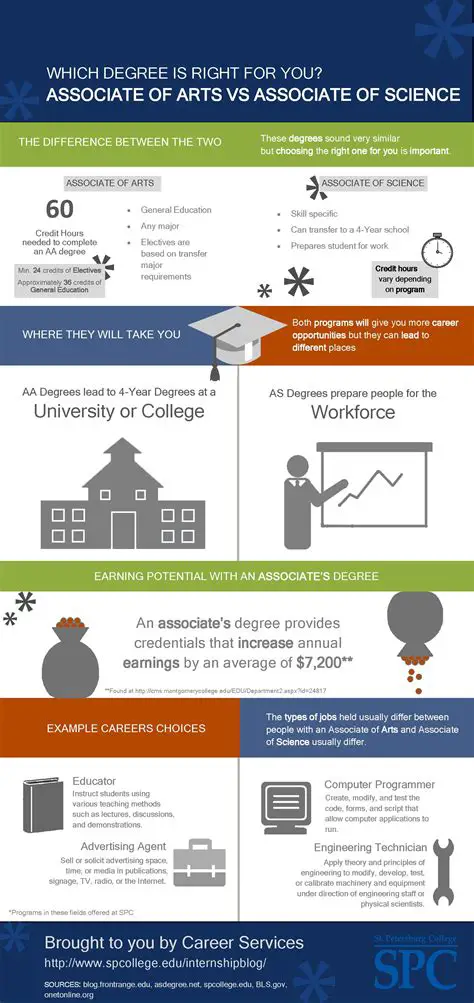In the realm of higher education, understanding the nuances between different degree types is crucial for aspiring students. Two commonly sought-after options are the Associate of Arts (A.A.) degree and the Associate of Science (A.S.) degree. While both serve as valuable gateways to further academic or career opportunities, they differ in their specific focus and requirements.

Key Differences
| Feature | A.A. Degree | A.S. Degree |
|---|---|---|
| Primary Focus | Liberal Arts and Humanities | Science, Technology, Engineering, and Mathematics (STEM) |
| Coursework | Emphasizes subjects such as English, history, philosophy, and social sciences | Concentrates on math, science, and technology-related fields, including biology, chemistry, and computer science |
| Career Paths | Prepares students for transfer to four-year universities or entry-level positions in fields like teaching, social work, or journalism | Often leads to direct entry into technical or science-based careers in fields such as healthcare, engineering, or computer programming |
| Program Duration | Typically 60 credit hours | Typically 60 credit hours |
Understanding the A.A. Degree
Focus and Coursework:
The A.A. degree is designed to provide a foundation in the liberal arts and humanities. It equips students with critical thinking, communication, and problem-solving skills through coursework in areas such as:
- English composition and literature
- History
- Philosophy
- Social sciences (e.g., psychology, sociology)
- Fine arts (e.g., music, art appreciation)
Career Paths:
Graduates with an A.A. degree have a broad range of career options. Many choose to transfer to four-year universities to pursue a bachelor’s degree. Popular transfer majors include English, history, teaching, and social work. Others seek employment in entry-level positions in fields such as journalism, library science, or human resources.
Understanding the A.S. Degree
Focus and Coursework:
The A.S. degree emphasizes science, technology, engineering, and mathematics (STEM) fields. It provides students with a strong foundation in these disciplines through coursework in:
- Math (e.g., calculus, statistics)
- Biology
- Physics
- Chemistry
- Computer science
Career Paths:
The A.S. degree prepares students for immediate entry into the workforce in science-related fields. Common career options include:
- Medical laboratory technician
- Engineering technician
- Computer programmer
- Healthcare worker
- Science teacher
Making the Decision
Choosing between an A.A. and A.S. degree depends on individual career goals and interests.
- Students interested in transferring to a four-year university: An A.A. degree provides a solid foundation and enables students to explore a wider range of majors before specializing at the bachelor’s level.
- Students seeking immediate entry into the workforce: An A.S. degree offers a focused path towards STEM-based careers.
Additional Considerations
- Credit Transfer: Students planning to transfer to a university should carefully research which credits will be accepted at their desired institution.
- Cost and Time: Both A.A. and A.S. degrees typically take two years to complete, with comparable tuition costs at most colleges and universities.
- Online and Hybrid Options: Many colleges and universities offer online or hybrid A.A. and A.S. programs, providing flexibility for students with busy schedules.
Case Study: From A.A. to STEM Success
Sarah, a high school graduate with a strong interest in science, enrolled in an A.A. program at her local community college. After completing her coursework, she transferred to a four-year university and pursued a bachelor’s degree in chemistry. Upon graduation, Sarah secured a research position at a pharmaceutical company, where she used her skills in scientific analysis and problem-solving to develop innovative drugs.
Innovative Idea: The “STEMbridge”
The “STEMbridge” concept proposes connecting A.A. and A.S. degree programs to create a seamless pathway from introductory liberal arts courses to advanced STEM education. This would encourage more students to pursue STEM careers by providing a structured bridge between different academic disciplines.
Four Useful Tables
| Table 1: Job Outlook for A.A. Graduates |
|—|—|
| Occupation | Projected Growth Rate (2021-2031) |
| Kindergarten and elementary school teachers | 7% |
| Social and human service assistants | 12% |
| Library technicians | 9% |
| Journalists and news analysts | 0% |
| Table 2: Job Outlook for A.S. Graduates |
|—|—|
| Occupation | Projected Growth Rate (2021-2031) |
| Medical and clinical laboratory technicians | 15% |
| Computer and information research scientists | 11% |
| Engineering technicians | 8% |
| Computer network architects | 15% |
| Table 3: Common Mistakes to Avoid |
|—|—|
| Mistake | Description |
| Not researching credit transferability | Can result in wasted time and effort when credits are not accepted by the desired university. |
| Choosing a degree based on salary alone | Job satisfaction should also be a primary consideration. |
| Not using academic advising | Can lead to missed opportunities for scholarships, internships, and other support services. |
| Table 4: Effective Strategies for Success |
|—|—|
| Strategy | Description |
| Set clear career goals | Determine the specific field or industry you want to work in. |
| Attend class regularly and participate actively | Engagement and attendance boost understanding and retention. |
| Utilize campus resources | Take advantage of tutoring, counseling, and career services to enhance your academic and professional development. |
